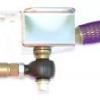
Wheel Spacers
#1

Posted 15 December 2018 - 10:30 AM
Cheers
#2

Posted 16 December 2018 - 10:04 AM
Sent from my iPhone using Tapatalk
#3

Posted 16 December 2018 - 12:21 PM
But the steering could feel strange changing the ET yoo much at the front. Exsct hoe much is hard to say. 10mm should be OK, maybe more.
You’ll knacker your wheel bearings if you put too wider spacers on unless you change the offset of the wheels you are using to match. Then that kind of defeats the point. You’ll be better off with a wider rim and the same offsets so as not to put unnecessary strain on the bearing.
Sent from my iPhone using Tapatalk
#4

Posted 16 December 2018 - 12:47 PM
The radial loads on the bearing are a function of the offset between the bearing centre and the average lateral and vertical pressure area of the tyre, it doesn't matter what the wheel offset or ET, etc are, only the final lateral position of the tyre assuming the same rolling Rad.
![]()
#5

Posted 16 December 2018 - 01:34 PM
So it's like having ET 20 wheels at the front end
#6

Posted 20 December 2018 - 02:49 PM
The radial loads on the bearing are a function of the offset between the bearing centre and the average lateral and vertical pressure area of the tyre, it doesn't matter what the wheel offset or ET, etc are, only the final lateral position of the tyre assuming the same rolling Rad.
Adding plus or minus to the offset changes where the centre of the tyre is in relation to the bearing though no?
For examples, if you have a 200mm wide tyre face with an ET of say +30mm the mating face of the wheel to the hub would be 70mm approx from the outside edge of the tyre, and if we say the centre of the tyre is directly above the bearing in this example. If you add a spacer of 10mm you would change the ET to +40mm, increasing the distance between the mating face and the outside edge of the tyre by +10mm and moving the centre line of the tyre +10mm outwards from the bearing. This gives the tyre a greater moment on the bearing meaning it would be subject to a twisting force for which it was not designed, potentially twisting the ball race in the bearing into the outer cover, increasing wear?
I have simplified the explanation a bit, but adjusting offset totals would put undesigned consisitant load on the bearing regardless of the weight of the vehicle...
Or maybe I am chatting poop ![]()
Edited by TheRealVXed, 20 December 2018 - 02:50 PM.
#7

Posted 20 December 2018 - 02:55 PM
True, but you also have the same bearing front and rear now, and OEM is ET26 front and ET 36 rear.
ET30 + 10mm spacer is ET 20 not 40.
The radial loads on the bearing are a function of the offset between the bearing centre and the average lateral and vertical pressure area of the tyre, it doesn't matter what the wheel offset or ET, etc are, only the final lateral position of the tyre assuming the same rolling Rad.
Adding plus or minus to the offset changes where the centre of the tyre is in relation to the bearing though no?
For examples, if you have a 200mm wide tyre face with an ET of say +30mm the mating face of the wheel to the hub would be 70mm approx from the outside edge of the tyre, and if we say the centre of the tyre is directly above the bearing in this example. If you add a spacer of 10mm you would change the ET to +40mm, increasing the distance between the mating face and the outside edge of the tyre by +10mm and moving the centre line of the tyre +10mm outwards from the bearing. This gives the tyre a greater moment on the bearing meaning it would be subject to a twisting force for which it was not designed, potentially twisting the ball race in the bearing into the outer cover, increasing wear?
I have simplified the explanation a bit, but adjusting offset totals would put undesigned consisitant load on the bearing regardless of the weight of the vehicle...
Or maybe I am chatting poop
#8

Posted 20 December 2018 - 03:14 PM
The radial loads on the bearing are a function of the offset between the bearing centre and the average lateral and vertical pressure area of the tyre, it doesn't matter what the wheel offset or ET, etc are, only the final lateral position of the tyre assuming the same rolling Rad.
Adding plus or minus to the offset changes where the centre of the tyre is in relation to the bearing though no?
For examples, if you have a 200mm wide tyre face with an ET of say +30mm the mating face of the wheel to the hub would be 70mm approx from the outside edge of the tyre, and if we say the centre of the tyre is directly above the bearing in this example. If you add a spacer of 10mm you would change the ET to +40mm, increasing the distance between the mating face and the outside edge of the tyre by +10mm and moving the centre line of the tyre +10mm outwards from the bearing. This gives the tyre a greater moment on the bearing meaning it would be subject to a twisting force for which it was not designed, potentially twisting the ball race in the bearing into the outer cover, increasing wear?
I have simplified the explanation a bit, but adjusting offset totals would put undesigned consisitant load on the bearing regardless of the weight of the vehicle...
Or maybe I am chatting poop
In isolation you are correct, the post was to clarify that wheel size/wheel width/wheel offset/spacers etc all have an individual effect but the end result in terms of radial loads on the bearing is purely a function of the bearing position relative to the tyre itself (all things being equal) and not all the intermediate references caused by different wheel ET's + spacers etc.
![]()
#9

Posted 20 December 2018 - 05:01 PM
True, but you also have the same bearing front and rear now, and OEM is ET26 front and ET 36 rear.
ET30 + 10mm spacer is ET 20 not 40.
The radial loads on the bearing are a function of the offset between the bearing centre and the average lateral and vertical pressure area of the tyre, it doesn't matter what the wheel offset or ET, etc are, only the final lateral position of the tyre assuming the same rolling Rad.
Adding plus or minus to the offset changes where the centre of the tyre is in relation to the bearing though no?
For examples, if you have a 200mm wide tyre face with an ET of say +30mm the mating face of the wheel to the hub would be 70mm approx from the outside edge of the tyre, and if we say the centre of the tyre is directly above the bearing in this example. If you add a spacer of 10mm you would change the ET to +40mm, increasing the distance between the mating face and the outside edge of the tyre by +10mm and moving the centre line of the tyre +10mm outwards from the bearing. This gives the tyre a greater moment on the bearing meaning it would be subject to a twisting force for which it was not designed, potentially twisting the ball race in the bearing into the outer cover, increasing wear?
I have simplified the explanation a bit, but adjusting offset totals would put undesigned consisitant load on the bearing regardless of the weight of the vehicle...
Or maybe I am chatting poop
Thanks for that ![]() makes sense to be ET20 not 40 for ET30 +10 as you actually move the mating face closer to the centre of the rim/tyre
makes sense to be ET20 not 40 for ET30 +10 as you actually move the mating face closer to the centre of the rim/tyre ![]() logistics fail
logistics fail ![]()
#10

Posted 20 December 2018 - 06:01 PM
Edited by Doctor Ed, 20 December 2018 - 06:02 PM.
0 user(s) are reading this topic
0 members, 0 guests, 0 anonymous users
















